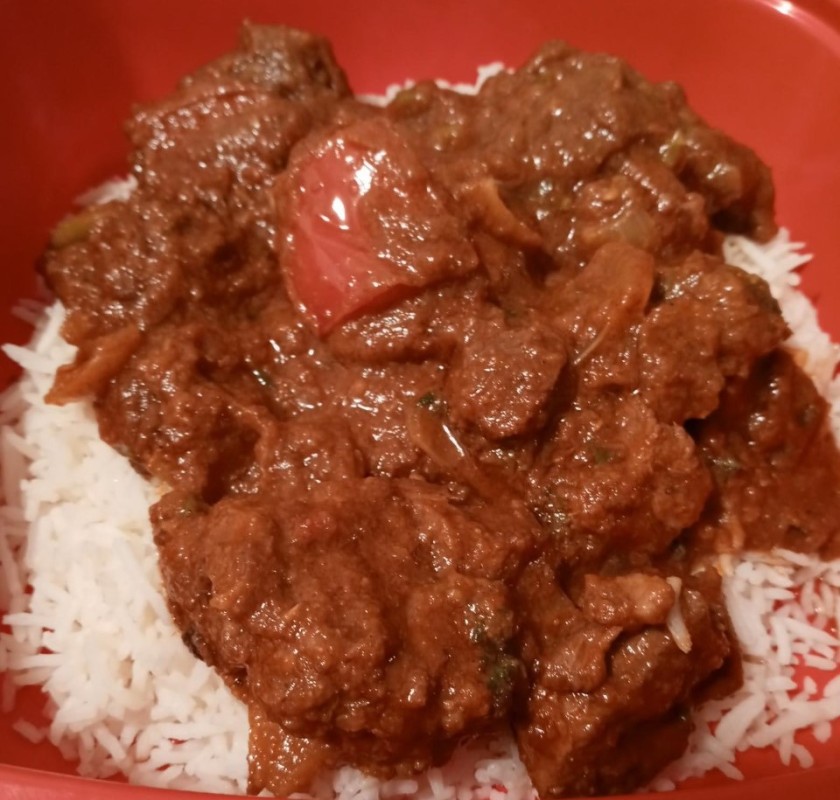I guess I haven’t published a new review in about a month, since work has been keeping me so busy. Working from home, I also haven’t been able to go out to eat quite as often, which means I’m cooking more and saving money (yet not losing any weight). But this review is long overdue, from a date night about a month ago at one of the prettiest, swankiest, sexiest restaurant/bar/lounges in Orlando, The Moderne (https://www.themodernebar.com/) in the foodie dream district of Mills 50. I’m sure a lot of my regular readers have already been here, but this was our first visit to The Moderne. I had been wanting to try it for a while, since it features an eclectic menu of small plates — mostly pan-Asian dishes, but some include other international influences, ranging from Italian to Peruvian.
This was my wife’s beautiful mojito mocktail, served with a dehydrated lime slice as a garnish. I tried a sip, and it was delicious. The Moderne features an enticing cocktail menu, but we were both happy to see a few mocktail options for non-drinkers like us. I guess you could call this one a “no”-jito.  My wife reminded me to mention that she first asked for a simple Shirley Temple, but the gorgeous, well-stocked bar did not have any grenadine syrup, something we both thought was odd at the time.
My wife reminded me to mention that she first asked for a simple Shirley Temple, but the gorgeous, well-stocked bar did not have any grenadine syrup, something we both thought was odd at the time.
Our order of duck wontons came out first. These hand-folded wonton wrappers were stuffed with shredded duck seasoned with Chinese five-spice powder and fried until crispy. They were served with chili oil peanut sauce. We both wished they had been served with more duck inside, even though they tasted good and were surprisingly not that oily.
This beautiful dish was the tuna kobachi, with spicy cubed tuna, avocado, Japanese-style marinated cucumbers, scallion, red tobiko, micro cilantro, and a dish of ponzu sauce for dippin’ and dunkin’. I loved it so much. I could eat this every day of my life and never get tired of it, although I’d hate to think of what my mercury levels would be. It was my favorite dish that we tried, a perfect 10/10. 
Next came our chashu quesadillas, which were plated beautifully. Quesadillas are the easiest thing to make at home, but my homemade ones never feature chashu pork, (like the kind of pork you get in a bowl of “real” (not instant) ramen), shredded cheddar and mozzarella cheeses, Japanese Kewpie mayo, chili amarillo sauce, and pickled onions. Well, mine would have the cheeses and Barbie Dream House-pink pickled onions, but that’s where the similarities begin and end.
This was another hit with both of us: yellowtail (hamachi) ceviche, with cubes of cool, refreshing yellowtail in mango wasabi lime sauce, diced onion, serrano, red tobiko, micro cilantro, all encased in perfectly thin, crispy, delicate spheres of pani puri, the Indian street food classic (see my Bombay Street Kitchen review for authentic pani puri). It was a gorgeous fusion experience that dazzled all of our senses.
My wife chose these miso cream noodles, which sounded like something she would love. The dish featured thin pasta (like angel hair or vermicelli), that chashu pork again, mushrooms, miso, fried garlic, toasted bread crumbs, parmesan cheese, and scallions. She admitted not really being into it and said it was both very rich and on the bland side — an interesting dichotomy, kind of like fettuccine alfredo from the Olive Garden (although this definitely had more flavor than that)! She picked at it and brought most of it home, where I happily finished it after picking the mushrooms out. I’m a pretty tolerant guy, but I have this unfortunate intolerance to mushrooms, and chefs freakin’ love throwing them into things.
I chose a different noodle dish for myself that seemed like another fragrant fusion feast: seafood pappardelle, with pappardelle pasta (wide, flat noodles that are wider than fettuccine), shrimp, tamarind Nikkei sauce (Nikkei being a Peruvian-Japanese fusion due to all the Japanese immigrants in Peru), carrots, red peppers, onions, peanuts, and a cilantro-heavy “Asian herb salad.” It was okay. The sauce was a little sweet and tangy, not as spicy as I had hoped, and very thin. I thought it was odd that the dish was called “seafood pappardelle” when the only seafood in it was shrimp. This was a last-minute choice when the server was already taking our orders, but I think I would have enjoyed one of the other noodle dishes more. Oh well, you live and you learn!

So that was our first experience at The Moderne. I liked it and would go back, but my wife admitted it was not one of her favorite restaurants. Oh well, people have different tastes and like different things — that is no surprise. My favorites were the two dishes with raw fish, which is usually one of my favorite things to eat. (This also explains why The Moderne’s neighbor a few doors down, Poke Hana, remains one of my favorite restaurants in all of Orlando all these years later.) I might get those again, or other raw fish options, and I would definitely try a different noodle dish on a second visit. Plus, after dinner at The Moderne, you can go next door and have some of Orlando’s finest ice cream at Sampaguita, which is exactly what we did on this date night!
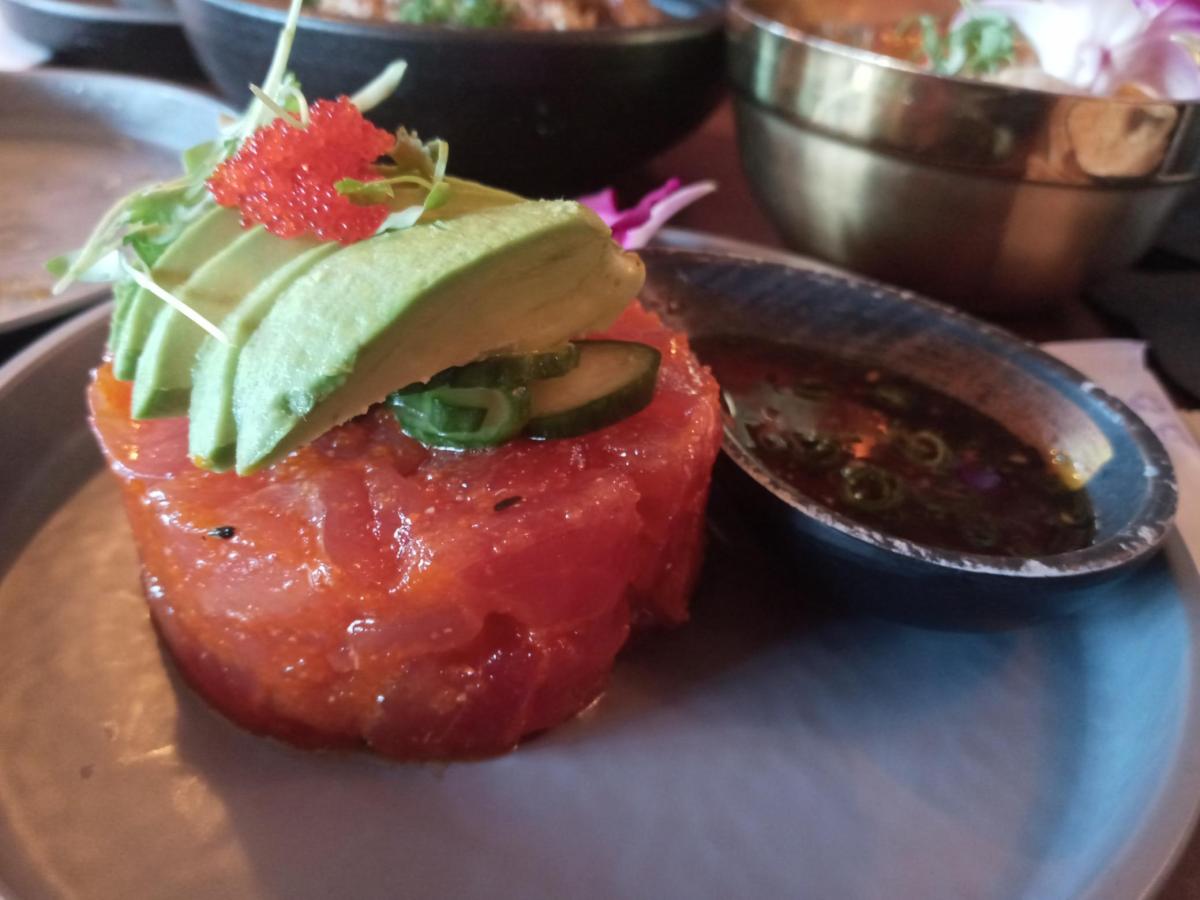


 Man, was this some luscious larb! Listed under the “Salads” on the menu, it was so bright and tangy, sour and spicy, crunchy and funky, and surprisingly cool and refreshing, while spicy enough to make my lips tingle. It was served chilled, with thin slices of onion, finely shredded carrot, cucumbers, and lots of mint, and it exceeded all my expectations with its blend of flavors and textures. I was a little surprised the larb did not come with rice, but what do I know? Anyway, it made me a larb lover for life.
Man, was this some luscious larb! Listed under the “Salads” on the menu, it was so bright and tangy, sour and spicy, crunchy and funky, and surprisingly cool and refreshing, while spicy enough to make my lips tingle. It was served chilled, with thin slices of onion, finely shredded carrot, cucumbers, and lots of mint, and it exceeded all my expectations with its blend of flavors and textures. I was a little surprised the larb did not come with rice, but what do I know? Anyway, it made me a larb lover for life.






 As always, I appreciated that Isan Zaap packed my takeout larb in one of those great plastic containers with a clear, locking lid. These are microwave-safe AND dishwasher-safe, and if you think I keep a collection of them, you’d be right as rain.
As always, I appreciated that Isan Zaap packed my takeout larb in one of those great plastic containers with a clear, locking lid. These are microwave-safe AND dishwasher-safe, and if you think I keep a collection of them, you’d be right as rain.







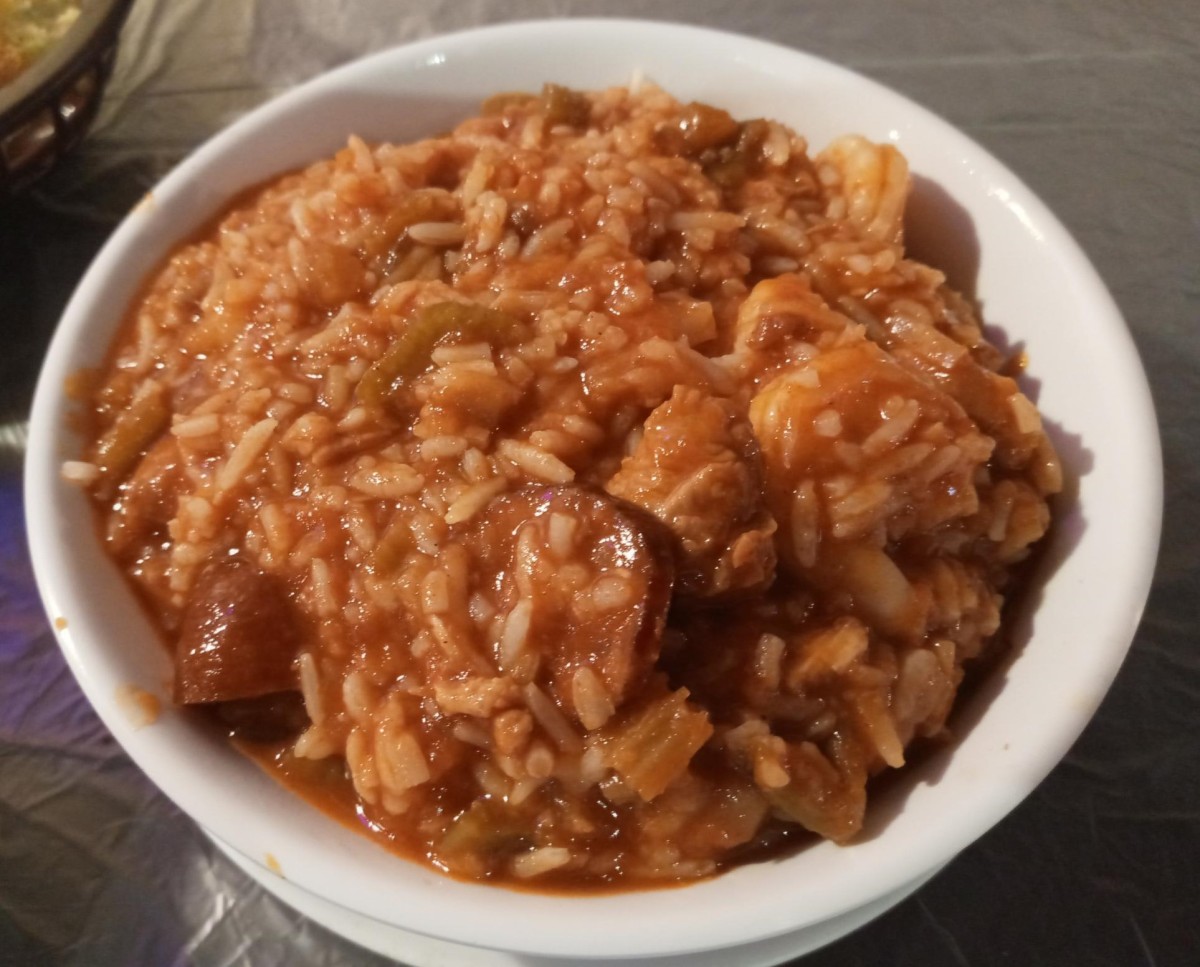
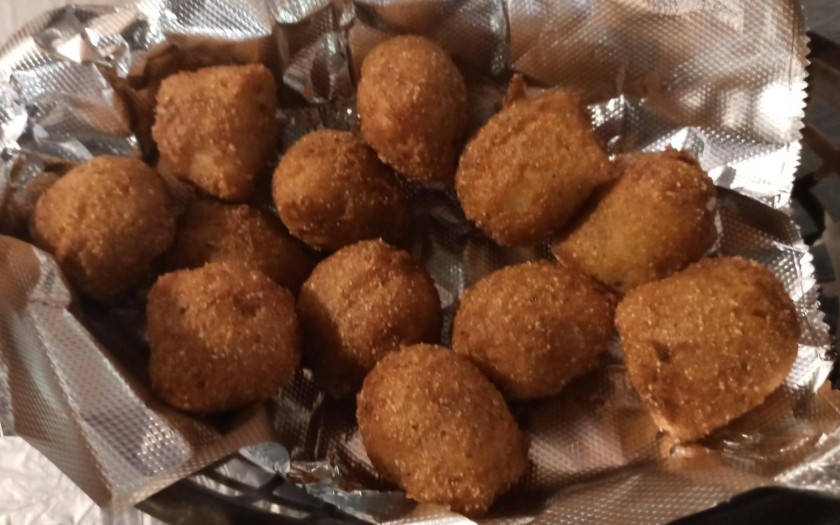
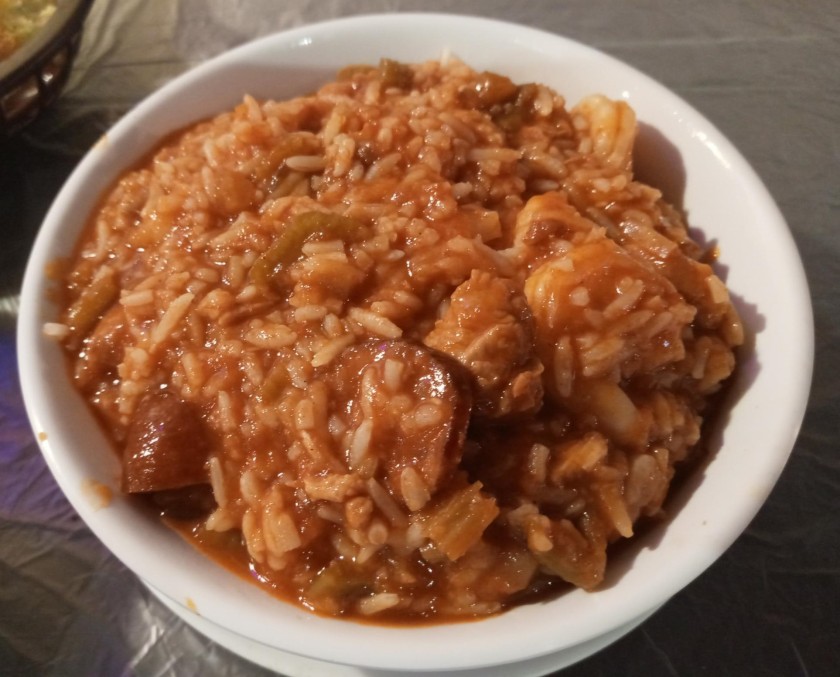
 Gumbo is more like a soup or stew than jambalaya, just in case you have confused them in the past. Both have similar ingredients, but gumbo always has more of a broth, with white rice on the bottom of the cup or bowl.
Gumbo is more like a soup or stew than jambalaya, just in case you have confused them in the past. Both have similar ingredients, but gumbo always has more of a broth, with white rice on the bottom of the cup or bowl.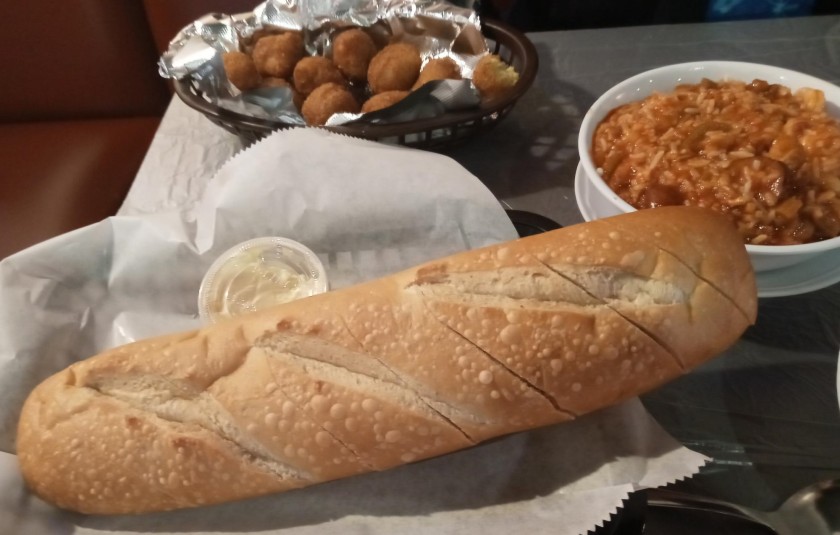
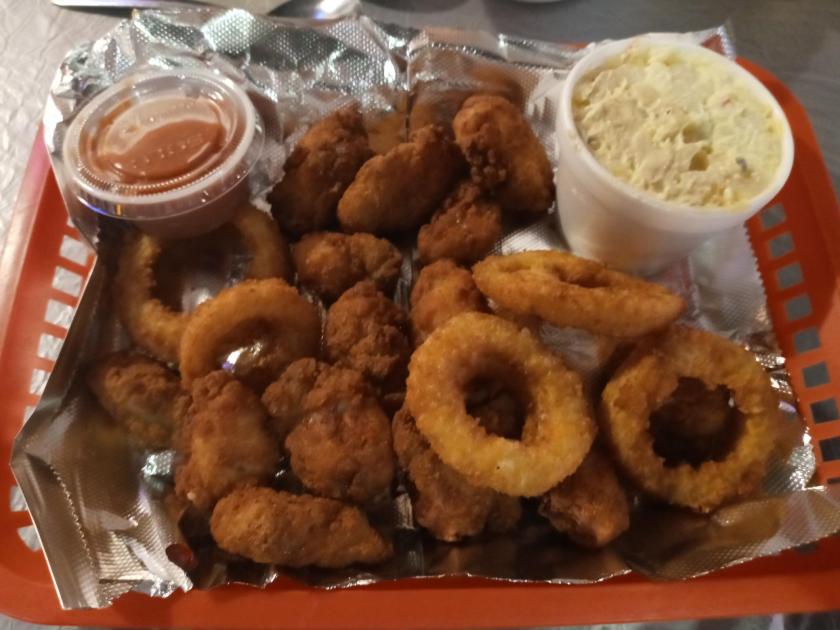 All the fried platters come with two sides. I chose potato salad and onion rings, so long-time Saboscrivner readers know this is also a RING THE ALARM! feature. The potato salad was cool and refreshing, tangy with a little yellow mustard the way Southern potato salads often are. The onion rings were breaded rather than battered, but they didn’t have those jagged crags that cut up the inside of your mouth, and the onions inside were at a reasonable temperature, not molten and scalding. I dipped the oysters and onion rings in the included cocktail sauce, but the remoulade (not pictured) was the best dipping sauce for both.
All the fried platters come with two sides. I chose potato salad and onion rings, so long-time Saboscrivner readers know this is also a RING THE ALARM! feature. The potato salad was cool and refreshing, tangy with a little yellow mustard the way Southern potato salads often are. The onion rings were breaded rather than battered, but they didn’t have those jagged crags that cut up the inside of your mouth, and the onions inside were at a reasonable temperature, not molten and scalding. I dipped the oysters and onion rings in the included cocktail sauce, but the remoulade (not pictured) was the best dipping sauce for both.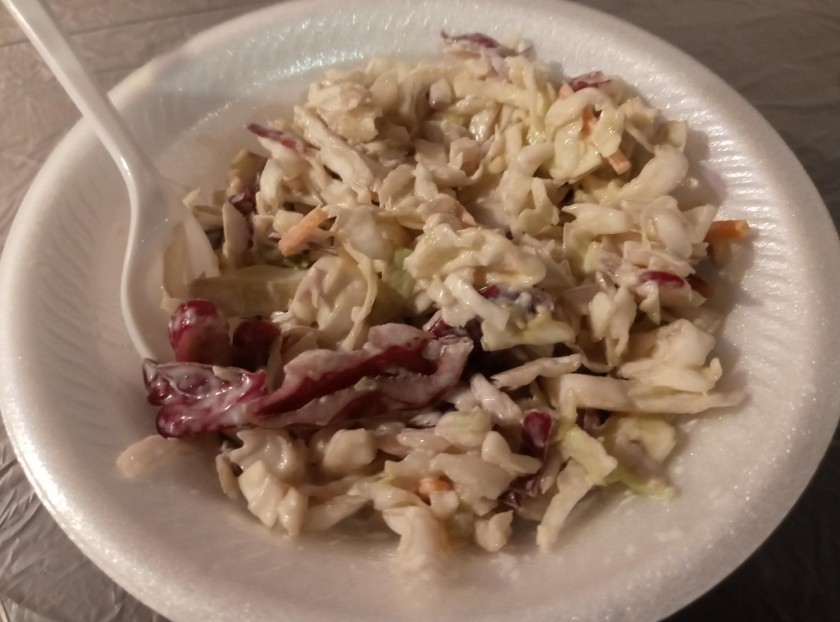
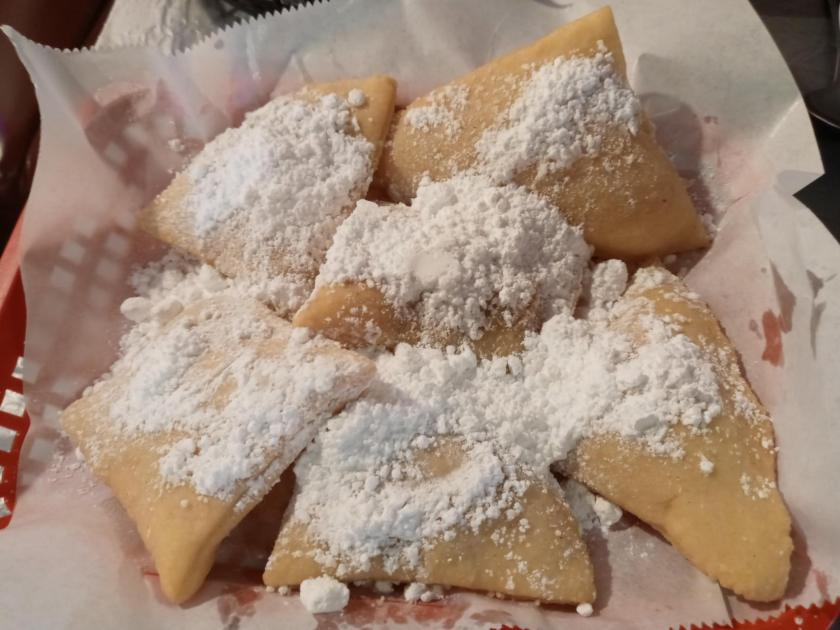
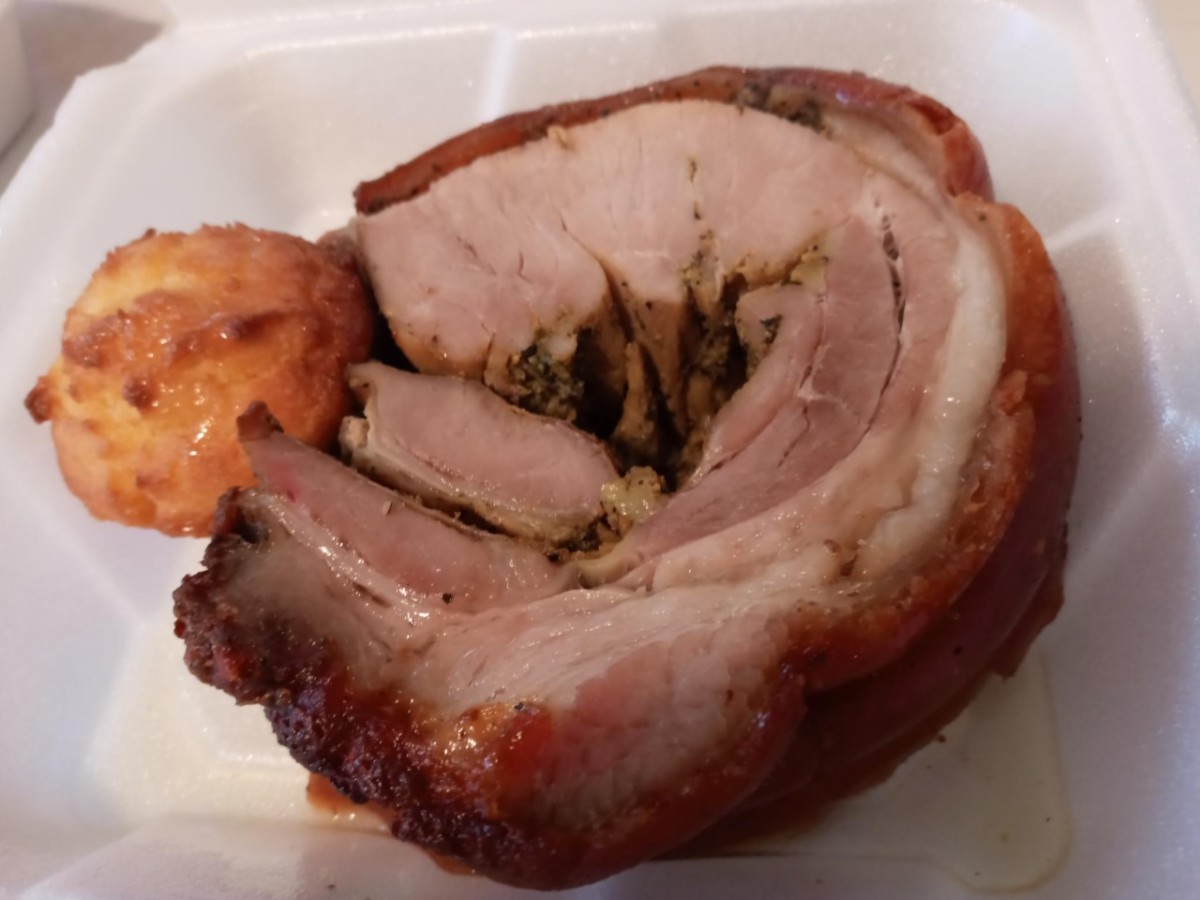


 For one of my sides, I chose the arroz blanco con habichuelas rosadas, white rice and pink beans, which were awesome. Again, the rice was plated beautifully, and the stewed beans were rich and meaty. I could have made a filling and satisfying meal of just those. They seemed to use short grain rice, which I associate more with sushi than Latin food, and it was so buttery. Latin restaurants always make better rice than whatever I make in my Aroma rice cooker at home. Could butter be the actual secret ingredient? It does make everything better!
For one of my sides, I chose the arroz blanco con habichuelas rosadas, white rice and pink beans, which were awesome. Again, the rice was plated beautifully, and the stewed beans were rich and meaty. I could have made a filling and satisfying meal of just those. They seemed to use short grain rice, which I associate more with sushi than Latin food, and it was so buttery. Latin restaurants always make better rice than whatever I make in my Aroma rice cooker at home. Could butter be the actual secret ingredient? It does make everything better!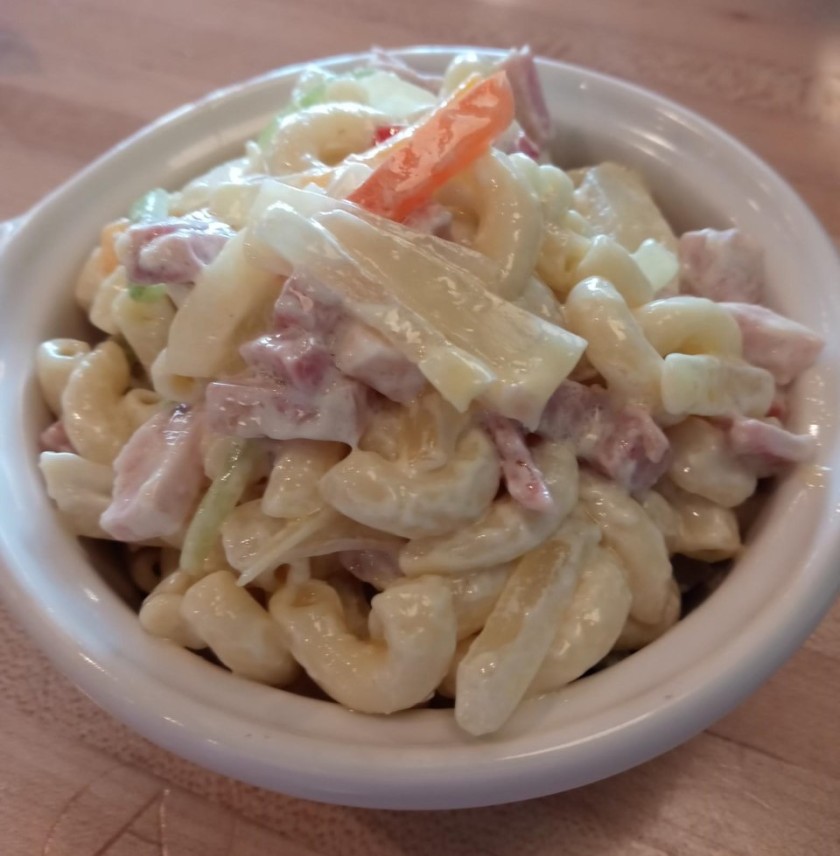







 This time, it came with a small corn muffin, that was moist and sweet and delicious — one more pleasant surprise and great little detail from Crocante. I like sweet cornbread, but it is dry and crumbly at a lot of places, including some Southern restaurants and barbecue joints that should know better.
This time, it came with a small corn muffin, that was moist and sweet and delicious — one more pleasant surprise and great little detail from Crocante. I like sweet cornbread, but it is dry and crumbly at a lot of places, including some Southern restaurants and barbecue joints that should know better.

































 I do love cooked greens, and the slight sweetness from the fruit made such a difference, especially with the tender crunch of the apples and the chewiness of the raisins (“Nature’s candy,” as my mom would say, trying desperately to convince my brother and I as little kids, and probably herself as well.)
I do love cooked greens, and the slight sweetness from the fruit made such a difference, especially with the tender crunch of the apples and the chewiness of the raisins (“Nature’s candy,” as my mom would say, trying desperately to convince my brother and I as little kids, and probably herself as well.)
 This is where I admit I’ve had bad experiences with paella elsewhere. Usually you pay a lot and wait a long time, and the rice comes out underdone. Just disheartening experiences overall, which is why I didn’t order a traditional rice-based paella for myself, even in this temple of Spanish cuisine, with a menu created by one of the greatest chefs in the world. Because the rice was tender and everything came together, it was probably the best paella I’ve ever had.
This is where I admit I’ve had bad experiences with paella elsewhere. Usually you pay a lot and wait a long time, and the rice comes out underdone. Just disheartening experiences overall, which is why I didn’t order a traditional rice-based paella for myself, even in this temple of Spanish cuisine, with a menu created by one of the greatest chefs in the world. Because the rice was tender and everything came together, it was probably the best paella I’ve ever had. The pasta was al dente in places, but the edges that touched the pan were crispy like pegao, the crispy rice from the bottom of the rice cooker that some people dismiss but others (like my wife) love. The dollops of creamy, garlicky aioli stood out against the blackness of the pasta and the blackness of the pan, reminding me of a line Alan Moore wrote in the comic book Top Ten #8, later plagiarized by Nic Pizzolatto in the first season finale of True Detective, about seeing stars shining in the night sky, and how there is so much darkness out there, but just to see any light at all means the light is winning. Well, nobody else wanted anything to do with my rossejat negra, which means I was definitely winning!
The pasta was al dente in places, but the edges that touched the pan were crispy like pegao, the crispy rice from the bottom of the rice cooker that some people dismiss but others (like my wife) love. The dollops of creamy, garlicky aioli stood out against the blackness of the pasta and the blackness of the pan, reminding me of a line Alan Moore wrote in the comic book Top Ten #8, later plagiarized by Nic Pizzolatto in the first season finale of True Detective, about seeing stars shining in the night sky, and how there is so much darkness out there, but just to see any light at all means the light is winning. Well, nobody else wanted anything to do with my rossejat negra, which means I was definitely winning!
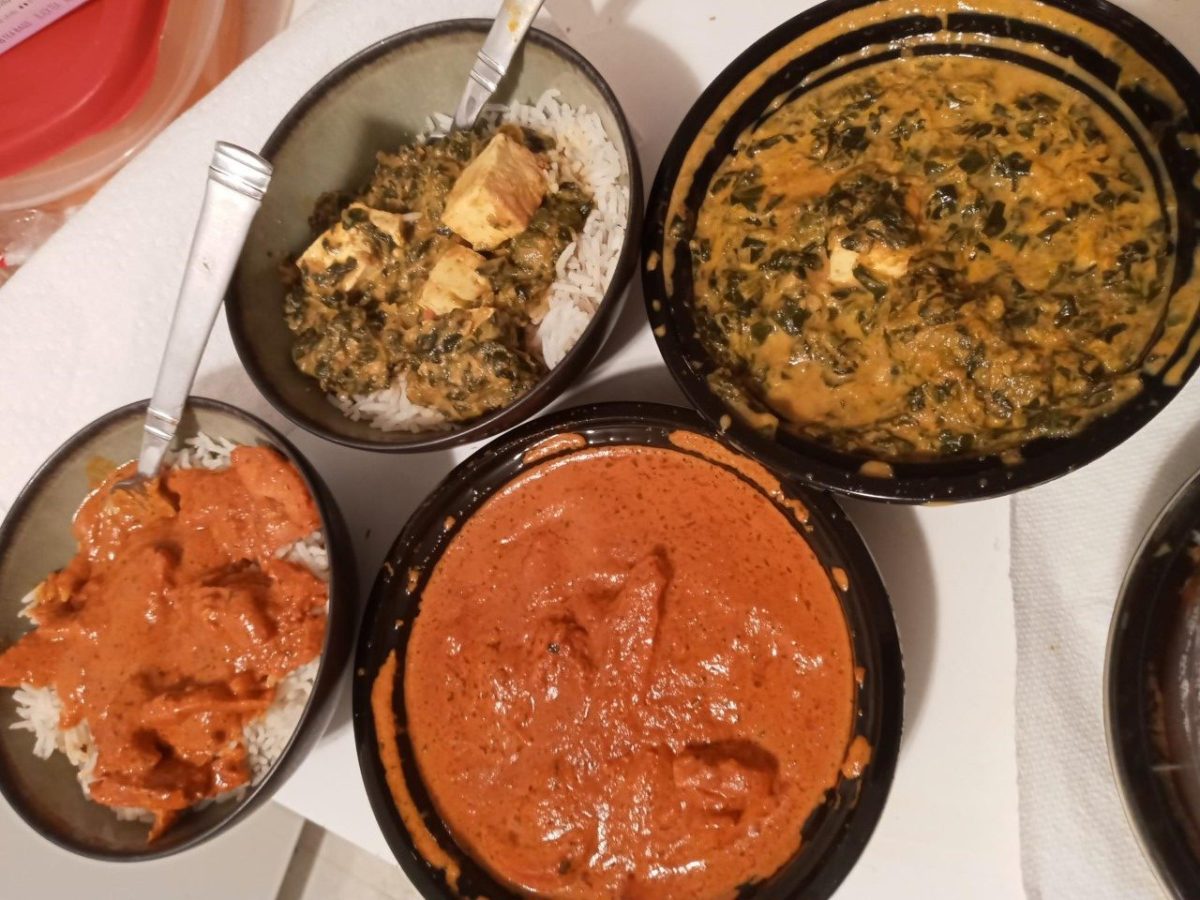
 The palak paneer is cubes of cottage cheese (the paneer part) cooked with spinach in a creamy sauce. It is another great gateway dish for people unfamiliar with Indian cuisine, especially vegetarians. I’ve ordered an extremely similar dish called saag paneer at other Indian restaurants, but I just researched the difference: palak paneer is always made with spinach, while saag paneer can be made with spinach and/or any other leafy greens, particularly mustard greens. Mystery solved!
The palak paneer is cubes of cottage cheese (the paneer part) cooked with spinach in a creamy sauce. It is another great gateway dish for people unfamiliar with Indian cuisine, especially vegetarians. I’ve ordered an extremely similar dish called saag paneer at other Indian restaurants, but I just researched the difference: palak paneer is always made with spinach, while saag paneer can be made with spinach and/or any other leafy greens, particularly mustard greens. Mystery solved!